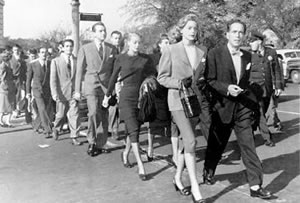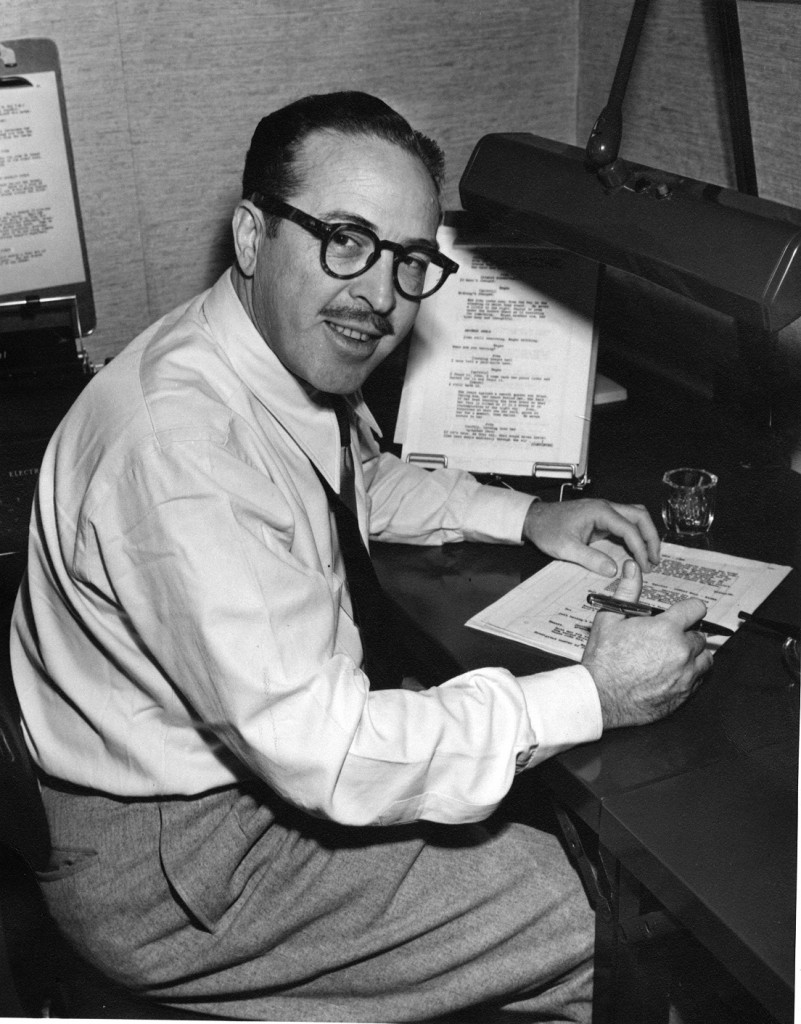Trumbo, red shadows over Hollywood
Movie and History «Trumbo», a movie by Jay Roach tells the story of the anti-red hysteria in the U.S. during the Fifties and the personal story of Dalton Trumbo, the most famous of the persecuted artists. A story not so distant from today
 Bryan Cranston and Diane Lane in "Trumbo"
Bryan Cranston and Diane Lane in "Trumbo"Movie and History «Trumbo», a movie by Jay Roach tells the story of the anti-red hysteria in the U.S. during the Fifties and the personal story of Dalton Trumbo, the most famous of the persecuted artists. A story not so distant from today
When ultraconservative Republican presidential hopeful Ted Cruz recently compared his putative Democratic opponents to “Bolsheviks and Mensheviks” he wasn’t so much engaging in rhetorical hyperbole as simply articulating standard American vernacular. In the same way, when Obama is attacked as a Socialist – as he has been throughout his presidency by conservatives and pundits of Fox news – the word is used as a slur, an insult hurled as the ultimate vilification. And to many millions (certainly in what is ironically termed “Red America”) no further qualification is necessary.
American demonization of Communism and Socialism is borne of unfamiliarity and is the singular heritage of the American century and its apex in the cold war. It was during the mid-twentieth century red scare that the rethoric still breezily deployed by the likes of Cruz bore its poisonous fruit in what amounted to a state run organized campaign of political persecution (of artists an intellectuals).
A new film by Jay Roach, Trumbo, tells the story of McCarthyism’s most visible victim. Dalton Trumbo (played by Breaking Bad’s Ryan Cranston), the author of films like Spartacus and Papillon was a the most visible member of the “Hollywood Ten” who, summoned by the House Un-American Activities Committee, refused to state whether they “were now or had ever been” members of the communist party, on the grounds that the very question infringed on rights protected by the first amendment of the constitution. Their stance cost them jail sentences for contempt of congress and Trumbo, who had been the highest paid screenwriter in Hollywood spent ten months in a federal penitentiary.
Prison was however only part of the punishment, the real penalty for their thought- crime was banishment from the profession as artists and intellectuals were added to a black list similar to the ones used to ostracize Jews and dissidents in fascist Italy or Stalinist Russia. Thus was a formerly unknown tyranny visited on the great American democracy which just a few years prior had emerged as victor in war to lead the “Free World”.
https://youtu.be/WVQOU3dRZj0
So ingrained is the notion of the motherland of modern capital as physiologically antithetical to communism, that it is easy to forget that this country had its own communist party. The CPUSA had 60,000 members just months after its founding in 1919 (two years before the Chinese counterpart, incidentally), ranking at the time as one of the largest communist parties outside of Russia.
A robust American left emerged from early union struggles that pitted workers against early capitalist oligarchies in the days of robber barons.
Socialist, communist and anarchist militancy underpinned a class struggle which often turned bloody. Those struggles produced a solid culture of progressive ideology. In 1912 Eugene Debs, founder of the radical internationalist International Workers of the World (the Wobblies), garnered 6% of the popular vote in his presidential run.
It was, ironically, after Roosevelt’s New Deal had coopted many of the demands of the left, adopting government policies that today would be considered wildly radical, that the backlash began in earnest.
In 1947, as cold war paranoia quickly escalated, the Truman administration introduced compulsory oaths of loyalty for federal employees. Using the same justification against foreign subversive agents that a few years earlier had been used to imprison ethnic Japanese citizens in concentration camps, the practice rapidly widened.

The vacuous glamour of Tinseltown might have seemed like an unlikely frontline for the epochal clash of the opposing ideologies of the twentieth century, and yet under the palms and searchlights a persecution played out identical, in spirit at least, to the Stalinist purges the inquisitors purported to abhor.
Screenwriters may not have been equivalent to Russia’s dissident avant-garde but many had committed the heresy of progressive thought.
The traditional creative lumpen class in the film industry’s supply chain, many writers labored in the intellectual tradition of Jack London, Paul Robeson and Upton Sinclair (that writer narrowly missed becoming a socialist governor of California in 1938 – before being stopped by a slander campaign to which Louis B. Mayer famously contributed fake MGM newsreels).
Thus came the screenwriters (as well as directors, actors and production workers) to find themselves squarely in the sights of the House Un-American Activities Committee. They became the object of a pogrom that divided the nation and deeply scarred Hollywood.
As former SAG president and activist actor Ed Asner told il manifesto just ten years ago: “Its most malicious contribution to postwar history was to obscure forever the truth about communism in Hollywood. Yeah, we had communists. And later it was shown that thoughts are not crimes! A lot of people were drummed out of town, out of life of business the country for doing something that was legal – for trying to help the world.”
In the annals of American fascisms, from the armed union-busting of the Coalfield Wars to the Japanese camps, the inquisition of Hollywood writers stands as particularly sinister for its Orwellian apparatus of thought police and banishment.
“The legitimate fear of totalitarianism,” says Trumbo director Jay Roach, “was turned into another kind of totalitarianism here, which was ‘either you conform to our idea of what America-ism means – the idea that Hedda Hopper and the Motion Picture Alliance had of it – or you lost your job.”
https://youtu.be/v7-Zn0djQDs
The truly heinous mechanism was to pit friends and colleagues against each other, demanding purification though ritual recantation and denunciation. The many boos that met Elia Kazan (who did eventually name names), as he accepted his academy award almost half a century later in 1999, testify to the depth of the inflicted wounds.
Given that fact, surprisingly few films have dealt with the backlist as subject matter.
These include the earnestly melodramatic Guilty by Suspicion (1991), by Irvin Winkler and Martin Ritt’s irreverent tragicomedy The Front (1976) with Woody Allen and Zero Mostel.
Trumbo tells the story almost in the manner of a screwball comedy or perhaps a screenplay that Trumbo himself might have penned. The film focuses on the role of the Motion Picture Alliance whose meetings at the old American Legion hall on Highland, just a stone’s throw from Graumann’s Chinese theater promoted a reactionary “patriotic” agenda with the participation of gossip columnist Hedda Hopper, John Wayne, Ronald Reagan and Walt Disney among others.
“They would meet there and talk about all these rabble rousing and unionizing lefties who weren’t patriotic enough,” says Roach. “and they wrote letters and asked to Congress to come here and investigate”. The director suggests that the blacklist was a way as well to settle labor grudges that had polarized the industry. “Most of the Hollywood Ten were writers who had taken the side of the Writer’s Guild over the other union which was a studio friendly union called The Screenplay Wrights, (…) guys like James McGinnis (who) founded the MPA”.
The film begins with the hearings and continues as Dalton Trumbo continues to work under assumed names eventually enlisting many other blacklisted writers to supply scripts, initially to small-time producers of B-movies like the artistically redoubtable King Brothers. A black-market end run around the blacklist that actually earned Trumbo two academy awards, for Roman Holiday (1953) and The Brave One (1954).
The blacklist was effectively broken when Otto Preminger and Kirk Douglas in 1960 decided to give screen credit to Trumbo for Exodus and Spartacus respectively. The latter film ironically inspired by the slave rebellion story that had also given the name to the communist party of the Weimar republic. It’s an ending befitting a story that would seem, well, written for the screen.
Today a presidential candidate like Bernie Sanders dares to declare himself a “socialist” for the first time, one century after Debs’ campaign, a new wave of hate speech is directed at Hollywood actors and directors who dare express taboo opinions (witness the backlash and boycott against Quentin Tarantino for having spoken against police killings).
On that backdrop Trumbo’s retelling of a not-too-distant witch-hunt seems an altogether fitting cautionary tale. “You may not want to turn on the artists and try to suppress them as your first line of attack,” concludes Roach, “because they might be speaking the truth that no one else can speak.”
–> Originally published in Italian at il manifesto on Nov. 6 2015

I consigli di mema
Gli articoli dall'Archivio per approfondire questo argomento